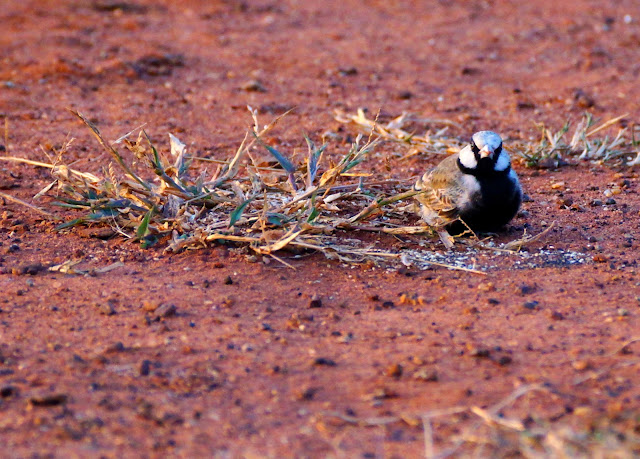Destination Badami
Badami Or Vatapi is in the rugged region of North Karnataka. The red sandstone outcrop greets you the minute you drive out of the train station. You feel you have transported yourself to wild west and any minute a gun wielding outlaw or a cowboy could greet you.
Our conquest of Badami began with a bumpy ride in the local stage couch
or the Indian Auto rickshaw. Our stay in the Dry and Arid North
Karnataka was made better by the wonderful hospitality of Krishna
Heritage and its green surrounding of fields. The location was a gold
mine. Gold mine for Bee eaters, Coucals, Silver bill,Brahmini Starlings,
Indian rollers, Kingfishers, wagtails, sparrow larks, Munias, Bulbuls,
Babblers, parakeets and many more residents and migrant visitors.
Ashy Crowned Sparrow Lark
Large Grey Babbler
We started the
exploration of Badami with a visit to Banashankari Amma temple. An
incarnation of Goddess Parvathi,kuldevi of chalukyas resides in the
refurbished temple built in 1750. The original temple is dated to 7th
century AD.
Another
place of interest was the Mahakuta group of about 2 dozen temples built
between 6th to 8th century AD. Two inscriptions in the Mahakuteshwara
temple make it a place of historical significance. A natural mountain
spring flows within the temple complex and feeds
fresh water into a large tank called the Vishnu Pushkarni and an
ablution tank called Papavinasha Tirtha. There is a small shrine in the
center of the Vishnu
Pushkarni tank and in it is a Shiva linga called Panchamukha Linga, one
face for each
direction and one on top. It is believed that Papavinasha Tirtha is fed
from water from Kashi. The thick green cover from century old trees,
the scared water tank with noisy kids, the stone temples some of it
crumbling makes it North Karnataka's Angkor Wat.
This
part of Karnataka is known for IIkal sarees named after the town of
IIkal in Bagalkot district. You are never far from history in this area.
The traditional art of weaving the cotton saree with art silk border
and pallu is supposed to have originated in the 8th century AD. How can
one miss an opportunity to pick a piece of fabric drenched in history.
The straight lines or the checks that predominate the designs of these
saree work in this day and age too.
The most important place of interest in Badami is of course the caves. It is beautifully set next to Lake Agastya in admist the intricately time carved red sandstone cliffs.The immaculately maintained complex is a favorite among tourists as well as the naughty little menacing monkeys.
Natural Cave amidst the ravines of sandstone
The stairway to history
The Entrance to Cave 1
The Entrance to Cave 2
The Entrance to Cave 3
View of Lake Agastya from entrance of Cave 4
Rock cut architecture is found in abundance across India. I wondered why till I was told natural caves have always been given a place of sanctity in Hindu and Buddhist religion. Man made caves were an extension of this philosophy / religious idea of asceticism and the monastic life .Although free standing structural temples were being built by the 5th
century, rock-cut cave temples continued to be built in parallel. The caves of Badami were carved out between late 6th to 7th century.
Frieze of 18 armed dancing Shiva demonstrating the 9 different poses of Bharatnatyam at the entrance of Cave 1 dedicated to Shiva. Accompanying him are his son Ganesh , bull Nandi and a drummer.Other prominent sculptures include a two headed Ganesh, Mahishasura Mardini, Ardha Nareeshwara and Shankarnaryana.
The eight feet tall Ardhanareeshwara with sage
Bhringi (the skeleton like figurine),Nandi on left and Parvati in
the right, is another elegant sculpture. The left portion in the photo
is symbolic of male while the right is female.The fluted interior columns are more ornate than the exterior columns. The garland of beads, Iha Mrigas ( mythological animals) are among the other decorative elements that make the rock columns delicate.The verandha ceiling has five hooded Nagraj flanked by celestial couples.
Cave 2 is dedicated to Vishnu and has his avatars depicted in form of Trivikrama, Varaha and Krishna . The English judicial attire with the wigs came into existence in late 1600s. But seen here is similar style dating back to late 6th century
Cave 3 also dedicated to Vishnu, is the largest of the caves and most elaborate wrt sculptures and carvings. On one side of the verandha/mukha mandapa, Vishnu is depicted sitting instead of the usual reclining position on the coiled five headed Anant Shesh.
Panels of Trivikrama,Narsimha ,Shankaranaryana, Varaha ( a more intricate interpretation compared to cave 2), Anantasayana and Harihara seen here are engraved into the natural walls of man made cave.
The column corbels/brackets have intricately carved divine couples or yakshas. The clothing and culture of 6th century is prominently visible in the art of cave 3.
Cave 4 is dedicated to Jainism. Parshvanath was the 23rd Tirthankar and the most popular among Jains. Adishesh hoods the head. The voluptuous Padmavati Yakshini holds an umbrella while her husband Dharanendra sits. The statues do not have clothes following the customs of Digambar Jains which means renunciation of all worldly possessions.
Badami was a fitting end to the trip back in History! The escape into the Almond hills was a memorable one filled with legends, history and religion. A do not miss destination!
Date : December 2014
Place : Badami, Karnataka
Tip
: Do not encourage the monkeys by carrying eatables or bags!
First :Wild West in India
The Travel Connection: We travel not to escape life but for life not to escape from us.
You may also like

























Comments